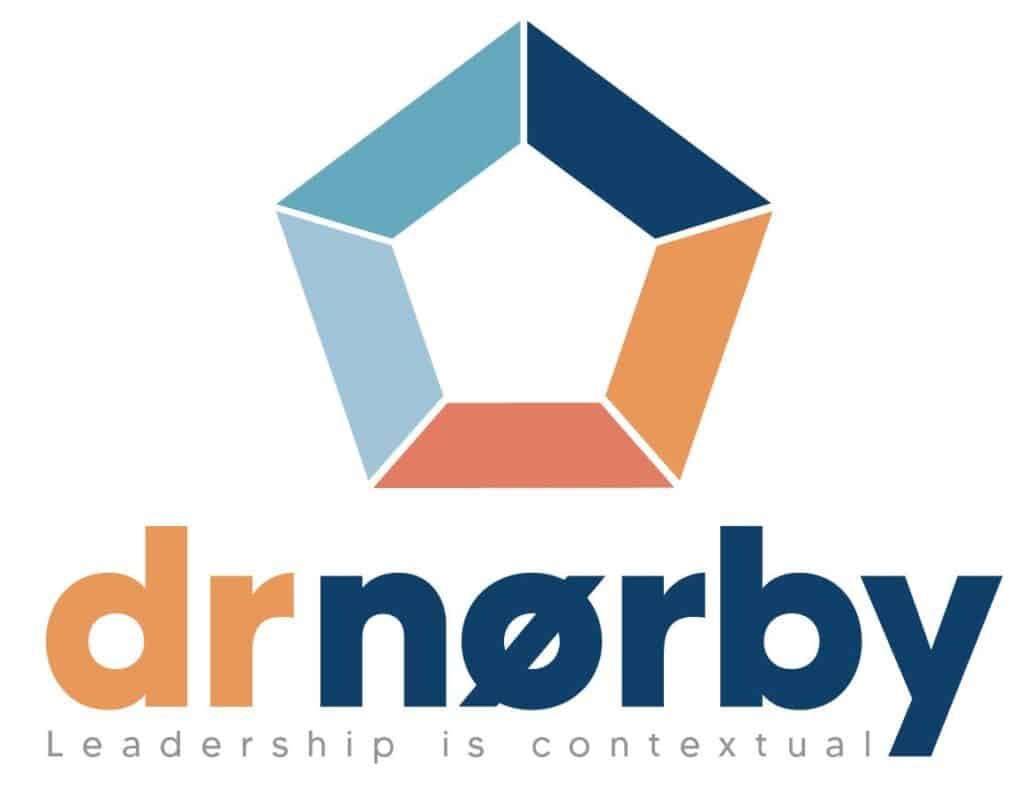Discover More about Contextual Leadership and the Five Layers of Intention, Environment, Structures, Cultures and People
Leadership context is the sum of factors holding the potential to influence leadership or its outcomes. Leadership outcomes are defined as the work performance behaviour and the engagement drivers behind the behaviour, which are most suited to promote the organisational culture, intentions and ambitions.
A global leadership context study involving more than 125 leadership experts confirmed a range of factors with guiding, helping and hindering effects.
The factors organise themselves into five layers of leadership context, which interact in a force field. The five layers of leadership context are briefly introduced hereunder.

The intentions concern the organisation’s mission, vision, strategy and operational priorities, tasking the leader to promote the fit-for-purpose performance in her part of the organisation.
The layer of organisational intentions exercises a significant guiding effect on leadership priorities and approaches. It determines which work performance behaviour is most important for the leader to promote.
Over time, the organisation can shift the balance between efficient operation and the energy invested in innovation forth and back. In both instances, the leader needs to interpret these intentions into effective leadership.
Based on an interpretation of the intentions, she should build engagement and promote the behaviour yielding the highest possible performance, rather than “just” lead as usual. Another vital part of the organisational intentions in the leadership context is the strength of the organisation’s purpose.
The leader must understand how to let the purpose permeate leadership and strengthen the organisational culture leading to high performance. There are significant differences in how central organisations hold their purpose, and it is the leader’s task to understand how to convert purpose into pride and meaning through effective leadership.
The environment comprises the external factors surrounding the leader’s organisation or team. The layer concerns factors in the market and the society exercising an influence on the organisational performance.
An organisation is nested into a broader market and societal system, and the level of openness between the organisation and its external environment sets the tone for how direct an influence the external factors exercise.
These factors are often outside the leader’s control. A leader needs to build collective awareness of the best contingent responses to the external environment, especially when certain factors hold the potential to exercise significant influence.
For example, when operating in an environment with high complexity and high dynamism or working in environments with severe threats which can manifest anytime, the leader should train and operate by standard contingent responses to make the organisation contextually effective.
Such contingencies build organisational capability to mitigate or leverage the effects of external risks, dynamic market movements, high external complexity or other external factors.
The structures in the leadership context are the layer of organisational design, processes, policies and procedures.
It lays out essential parts of the organisational playing field. For example, an effective leadership team should consider how the level of formalisation and the choices of what is centralised and what is delegated best reflect the current organisational intentions.
The structures hold great potential to help or hinder effective contextual leadership. The structures and the cultures can substitute a part of a leader’s direct leadership interventions in pursuit of organisational performance.
Contextual leadership is about setting the leadership context up to promote engagement and performance within an organisational context. It concerns leveraging the context to allow the leader to invest her leadership efforts in the highest-return areas. Thus, it is fascinating for any leadership team to consider aligning organisational intentions, structures and cultures.
In most cases, there will be parts of the structures, for example, specific corporate policies and procedures, which a leader does not hold a mandate to shape. However, often there are malleable parts of the structures that allow a leadership team to optimise their leadership context to best support performance — for example, formalising selected standards for work processes, communication or coordination.
The cultures represent the fourth layer of leadership context and concern the “way we do things around here” — the organisational habits and beliefs built over time.
There is more than one culture at play in a leadership context. Each of these cultures is related to particular functions in the organisation.
Examples are the safety culture, the collaboration culture and the learning culture. These cultures need to be understood in relation to the prioritised organisational intentions to promote performance optimally.
The organisational culture can be shaped through effective leadership interventions and close collaboration with the significant employees in any team.
An effective contextual leader also considers how shaping structures and changing the composition of people help build the best possible cultures for the organisation’s purpose and intentions.
The global leadership context study confirmed 12 such focused cultures, all significantly related to performance and malleable through leadership. The cultures offer a carrier wave that can extend the leadership influence when shaped in close collaboration with significant followers.
On the other hand, if the cultures are misaligned with the organisational intentions, the effects can hinder performance significantly. Hence, it is a vital part of contextual leadership to shape the cultures essential to value creation.
Why Is Leadership Context Important for Leaders, Recruiters and Leadership Developers?

Any leader, but especially leaders of leaders, should identify the contextual factors in each of the five layers which have a significant influence. The factors’ significance differs from context to context. Having the vital factors on the radar and sharing a language about their effects and the best contingent responses is a key task for any effective leadership team.
An effective leader needs to involve his team in interpreting the contextual demands and shaping the setting to best help his leadership when he is not directly involved. The leader must take responsibility for setting up his team for success by shaping an optimal leadership context. Building contextual awareness contributes considerably to higher performance.
Recruiters and head-hunters should consider the organisational context factors when analysing the critical success factors in a position they are filling. They need to understand the full range of contextual factors in the leadership context to help their clients focus on the essential ones in each case.
They should be the experts in interpreting contextual demands and dialogue with the hiring manager about which part of the context needs to be shaped to improve performance.
It is vital to uncover whether the new hire is tasked with strengthening empowered initiative, compliance, accelerating learning or optimising efficient operation. These desired outcomes relate to understanding how the leadership context is and should be. This sparring should be an integrated part of the value creation delivered by professional recruiters — internal or external.
The HR Partners responsible for onboarding should help the newcomer build awareness about the leadership context he is entering and, importantly, also assist in specifying what to sustain and what to change.
A shared language and awareness between the hiring manager, the new leader, his people and HR facilitating the integration increases the likelihood of success and reduces the time to high performance in the new position.
Onboarding is much more than introductions. It is about accelerating performance and integrating the new leader so he can perform.
In 2017, Harvard Business Review published the article “Onboarding isn’t Enough”. The study showed that a significant part of the failure factors for senior executives transitioning into new roles relate to not grasping the leadership context they are entering. Here HR can play a vital role with a considerable influence on the newcomer’s performance by being the stewards making sense of the leadership context.
Talent and leadership developers should understand how the leadership context across the various parts of the organisation demands different leadership and how talents can be rotated to get exposure to different leadership contexts to build the versatility necessary to grow as leaders.
A corporate leadership academy should raise the understanding of the leadership context. It should include guidance for effective contextual leadership in different functions: marketing and sales, operations, administrative functions and R&D.
Leaders must first build a shared frame of reference for the leadership context. Doing so allows the leaders to build the awareness of deliberately shaping the context and adapting their leadership style to maximise influence.
Many organisations have taken the first steps by considering the leadership level when they develop leaders and leadership. However, hierarchical placement is only one part of the leadership context, and effective leadership is contextual beyond the positional level.
A strengthened understanding of the leadership context holds the potential for better, more informed leadership decisions. This applies especially to leadership teams overseeing larger organisations and leaders moving positions internally.
What Is Contextual leadership?
- Effective contextual leadership is about recognising which parts of the leadership context are most important when choosing leadership interventions, shaping structures and cultures, and adjusting the team to perform.
- Contextual leadership is about setting the leadership context up to promote engagement and performance. It concerns leveraging the context to allow the leader to invest her leadership efforts in the highest-return areas. Thus, it is crucial for any leadership team to consider aligning organisational intentions, structures and cultures.
- Contextual leadership is when a leadership team with high contextual awareness makes choices that set the organisation up to perform — when the leadership team paves the way and strengthens the contextual factors that help performance emerge.

Shaping the leadership context

The global leadership context study confirmed a three-step cycle at the heart of being a contextually effective leader — the PIA Cycle.
Firstly, understanding the Priorities and Principles related to any contextual factor is necessary for being contextually effective. Recognising “what is at play” is critical, whether it concerns understanding the vital part of the organisation’s strategy, key factors in the external environment or part of the existing cultures.
Secondly, the factors at play need to be Interpreted by Involving the team to uncover what effects the contextual dynamics will result in. The interpretation is about uncovering which helping, hindering and guiding effects the factors at play will trigger — and which balances they will shift. It is about committing to actions that will mitigate contextual influence and changing habits that can shape the context to promote performance.
Thirdly, converting the interpretation into Actions that can leverage the helping effects, mitigate the hindering effects and convert the guiding effects into appropriate actions. It is about Aligning behaviour through direct leadership or by shaping the leadership context. The global leadership context study confirmed the pattern across organisational, functional and national differences.
There are nuances to applying the three-step process depending on which part of the leadership context is being addressed. The method is unpacked in the book The Contextual Leader, along with insights into the different contextual factors, their effects and how to match best with leadership.
The Gains of Understanding Leadership Context

Match Leadership to Context. Lead effectively by understanding and matching the contextual demands.
Leadership is not a one-size-fits-all discipline. There is a range of universally important leadership practices like the Five Practices of Exemplary Leadership, understanding leadership as the outcomes of Direction, Alignment and Commitment or Transformational Leadership. Likewise, many corporations have their leadership principles as a joint frame of reference, providing the range of leadership practices that all leaders should master.
It is a challenge for these frameworks that they lack the discipline of understanding the context, which is a precondition for effective leadership!
If the leader does not recognise the contextual demands, it becomes difficult to apply the range of leadership practices most effectively. Effective leadership depends on context.
Contextual leadership concerns leading in context by understanding how contextual factors like risk intensity, centralisation, culture and the people composition call for certain leadership practices. Striking a balance between directive and participative leadership or hitting the right empowerment level are contextually dependent examples.
By understanding the leadership context, you can match your leadership practices to have maximum effect in the different parts of the organisation you lead.
Shape Context to Perform. Shape and leverage the context to promote performance.
The organisational culture can be shaped to promote performance. A stronger empowerment culture will result in more organisational agility. A stronger ethical culture can help leaders and employees navigate the dilemmas of hard choices.
A part of becoming an effective contextual leader is shaping the context by engaging in what the research uncovered as a key leadership discipline for being contextually effective — the PIA Cycles.
The leader should clarify the Priorities and Principles for the part of the context she is out to shape. Against the backdrop, she should Involve the team in Interpreting the conversion to action. How will we act this out and make it part of how we do things around here? The loop is closed by following through on the Acting and actively Aligning behaviour, beliefs and practices recurrently. That forms a learning cycle allowing the leader to shape the context and align processes, practices, culture and structures to promote performance.
By shaping context, you can remove hindering contextual effects and strengthen the contextual dynamics that result in higher performance and engagement.
Recruit across Contexts. Recruit successfully across industries and onboard new leaders faster.
The first success driver in recruitment is to ensure a qualified analysis of the critical success factors in the position you are recruiting for.
Secondly, personality testing with in-depth test tools, e.g. the Hogan Personality Inventories and, thirdly, cognitive testing, for example, with the SHL Cognitive Assessments.
Fourthly, interviewing the candidates using Behavioural Interviewing followed by the fifth success factor, which concerns collecting references from former employers. Together, these five practices result in a high prediction validity about future job success.
Understanding the leadership context allows robust analysis of the contextual demands and the desired future state of the organisation you are recruiting for. It significantly improves the interviews as comparing contextual factors across industries is much easier when the contextual frame of reference is well-warranted.
You considerably improve your job analysis and recruiting interviews with a strong frame of reference for leadership context. It gives you higher recruiting success, especially across different industries where contexts can be challenging to compare.
Tailor your leadership and talent development to fit your strategy and different contexts.
When training leaders, there are disciplines that all leaders should learn — no doubt. However, since leadership is highly contextual, any leadership academy, training or development intervention must be designed to fit the context. Understanding the contextual drivers and how they set demands on leadership practices is imperative to hit the mark and teach the most effective leadership tools, tips and tricks.
Uncover the three to five most important contextual factors for the leaders you will train. Ensure that these are present in cases and exercises to provide the participants with a much better outcome. They will build awareness about leveraging the context to promote performance and shaping the parts of the culture that need to evolve to fit the future strategy or remedy the current organisational challenges.
You will deliver better-tailored training with better fit-for-purpose curriculums by using the leadership context as a lens during fact-finding and design. You will build more contextual influential leaders resulting in a more engaged workforce and stronger performance.
Merge Contexts in Change. Understand the gaps in change, merger or acquisition and build a new high-performance context.
Change has changed, and today many leaders experience several simultaneous changes rolling into the organisation rather than facing a burning platform.
Change is a new normal. The attention to how context sustains old habits and that leaders need to shape the context to continuously meet the upcoming new requirements has never been more critical. Also, mergers go wrong when cultures, traditions and people clash.
The leadership context framework provides a shared language necessary to overcome some of these essential misalignments. It makes it easier to build a new shared reality optimised for performance. It provides the process for shaping the most difficult part for newly merged companies — the culture.
In the planning phases of any major organisational change, it is vital to identify which parts of the context can help the change come through and where we anticipate the challenges.
It could be differences in formalisation or centralisation on the structural side. There are usually attention points in the composition of the teams being changed or brought together. The organisational culture needs to be shaped, and its development cannot be left to coincidence. By engaging in the culture development process, the leaders actively facilitate a faster and less bumpy change management process.
By utilising the leadership context, you will succeed better in the ongoing change environment. You will also do better in large-scale change, mergers and acquisition by focusing on understanding and shaping the leadership context. You will reduce resistance to change, promote talent retention and lose less performance by including the workforce in creating the new context.
Sign up to access research insights through the blog repository
There Are Four Consecutive Studies behind the Findings on This Website!
If you’re interested in learning more about contextual leadership, you may wish to learn more about the studies that have informed my research.

The first qualitative interview study focused on critical leadership incidents related to leadership context. The study applied grounded theory to analyse 20 critical incidents collected through semi-structured interviews. The Critical Incidents identified were events where several factors in the leadership context played significant positive or negative influences on leadership and work performance. It resulted in the first learnings on the nature of leadership context, the contextual effects on leadership and work performance and effective contextual leadership.
The second study was an integrative literature analysis of 60 Review articles summarising the findings across 3,478 empirical and 400 conceptual studies. The study was used to theorise about leadership context, resulting in an initial framework for leadership context derived from how a range of leadership theories considers context. The approach allowed the integration of existing ideas about the influence of context across the piece-meal inclusion of a few contextual factors typical for most leadership studies.
The theoretical study pulled together a very fragmented field. In academic research, leadership context has usually played a secondary role over the past five to six decades. The lack of emphasis on leadership context is a paradox since everyone working in the business world with leadership development knows that context directly influences effective leadership.
However, in the research world, the context has historically only played a secondary role, or the studies have been focused on a particular part of the context, e.g. distance, work hazards, differences in national cultures or complexity in the surrounding environment. No studies putting leadership context at the centre were identified — perhaps because leadership context is a vastly complex subject. Maybe also because such a complex subject is challenging to fit into the reductionistic tradition common in academic research.
The third and primary study, the global leadership context study, developed and confirmed definitions of 28 contextual factors identified in the second study. It tested 69 hypotheses concerning the guiding, helping and hindering contextual effects influencing leadership and work performance. It tested eight propositions concerning leadership context and operationalised the concept of contextual strength. Read highlights about the experts who participated here.
The fourth study tested the Leadership Context Inventory (LCI), an instrument measuring the leadership context. It operationalises the understanding of leadership context for leaders, leadership developers, recruiters and researchers.
The LCI is a validated online survey delivering a rich report with diagnoses of the context and recommendations for optimising the context to promote performance and engagement. If you buy the book, The Contextual Leader, you gain access to a free trial of the LCI. The trial LCI provides a report with your diagnosis of the leadership context and recommendations for strengthening the context to support performance and engagement. You can see a sample report in the Products section.
If you are a leader and want to read the first two chapters of the book The Contextual Leader, please sign up
When you buy the book, you also get a free trial of The Leadership Context Inventory (LCI) and access to additional free resources. You can see sample reports in the Products section. The free trial will provide the short report version with the diagnoses of your specific leadership context.
The Contextual Leader is a book for senior leaders and middle managers who lead teams, departments, organisations or processes cutting across a matrix. It is based on doctoral research and twenty years of international leadership consulting experience. The book challenges the assumption that leadership is only about person-to-person influence and demonstrates how the organisational context should be actively shaped through leader-led interventions to set the organisation up for success.


